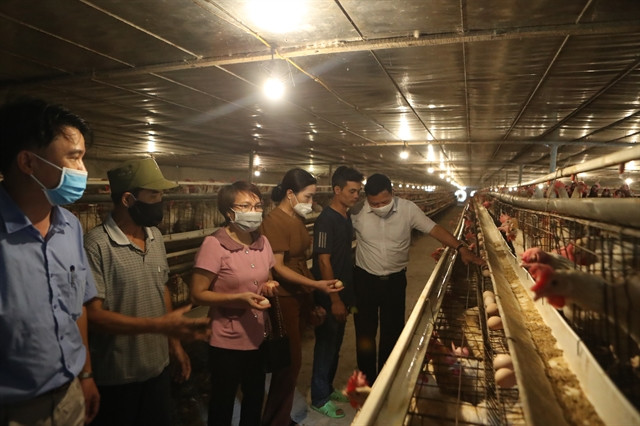 Experts visit a chicken raising model for clean eggs with high productivity in Thanh Oai district in Hanoi. (Photo courtesy of the Hanoi Sub-department of Agricultural, Forestry and Fisheries Quality Management)
Experts visit a chicken raising model for clean eggs with high productivity in Thanh Oai district in Hanoi. (Photo courtesy of the Hanoi Sub-department of Agricultural, Forestry and Fisheries Quality Management)Nguyen Giap Dong, head of the Ba Vi DistrictEconomic Division, said that the district currently maintained a safe teaproduction area spanning 1,550ha and productivity of 10.5 tonnes per hectareper year. The output for the whole year is estimated at 16,275 tonnes of freshbuds, worth 350 million VND (14,900 USD) per hectare per year.
To help farmers maintain and expand safeproduction areas, Ba Vi district has supported and created favourableconditions for localities to innovate technology, ensure raw material sourcesand well manage tea quality.
It builds trademarks, product brands protected byintellectual property; builds good models of safe tea production and processingfollowing Vietnamese Good Agricultural Practises (VietGAP) process.
Thanks to that, the district has successfullybuilt the Ba Vi tea brand.
In Dong Anh District, Nguyen Anh Dung, deputychairman of the district People’s Committee, said that the district had 1,180haof vegetable production area including more than 500ha of large-scale safevegetable production.
To control safe vegetable products’ quality, thedistrict has promoted education to raise people's awareness about limitingpesticides. As the result, the amount of pesticides decreased by about 15 percentcompared to previous years. Farmers have learned to use organic fertilisers,herbs and ensure food safety.
Regarding Hanoi’s plans for safe agriculturalproduction areas, Nguyen Thi Thu Hang, director of the Hanoi Sub-department ofAgricultural, Forestry and Fisheries Quality Management, said that the wholecity currently maintained over 5,000ha of safe vegetables areas including 43vegetable planting models applying the Participatory Guarantee System (PGS)with a total area of 1,700ha.
Hanoi also maintaines more than 1,300ha ofvegetables, fruits and tea according to VietGAP standards, 181ha of aquaculturein the direction of VietGAP, 88 livestock centres applying VietGAP standardsand nearly 50ha of farms following organic agriculture standards.
Besides, Hanoi continues to develop 141 chains ofsafe agricultural products manufacture and consumption.
Safety-oriented production not only helps farmerssell at prices which are 10-15 percent higher than traditional products, butalso helps sectors manage quality of products sold on the market.
To create sources of clean and safe food fromlarge-scale production areas, Nguyen Manh Hong, director of the Duc Phat Hi-techAgriculture Cooperative in Yen My commune, Thanh Tri district, said that Hanoineeded to invest in infrastructure in collective production areas, supportcooperatives and enterprises in capital with preferential interest rates whenbuilding safe production farms.
The capital city should also open training courseson high-tech application production, associate with enterprises to consume safeproducts, said Hong.
Deputy chairman of the Ung Hoa District People'sCommittee Ngo Tien Hoang said that the district continued to create favourableconditions to attract more and more potential enterprises to invest inagricultural production, expanding the scale of farm production areas andhigh-quality rice areas.
The district will expand high-tech safe vegetablesto 170ha, specialty fruit trees with brands in the market to 600ha, expandaquaculture areas in the direction of efficiency, sustainability, ecologicalenvironment protection in Hoa Lam, Tram Long and Trung Tu communes.
Director of the Hanoi Department of Agricultureand Rural Development Chu Phu My said that in the future, Hanoi's agriculturesector would continue to work with local authorities to expand centralisedproduction organisations together with high-tech applications, ecologicalagriculture, organic agriculture and advanced quality management systems.
The department will continue to guide and supportenterprises to invest in agriculture, multiply safe production models, supportfarmers with capital from the Hanoi Agricultural Promotion Fund to expandproduction scale, creating a source of clean food with clear origin to provideto consumers./.




























